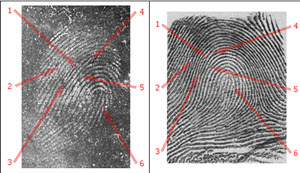
The word "latent" means "hidden" or "invisible." When fingerprints are involved, "latent prints" are those accidentally left behind by criminals during the commission of a crime. The story below, from the files of the FBI, details a cold case recently solved by a Massachusetts State Police Trooper using new database technology and latent fingerprints.
Every year, our Criminal Justice Information Services Division gives its Latent Hit of the Year Award to latent print examiners and/or law enforcement officers who solve a major violent crime using the Bureau's Integrated Automated Fingerprint Identification System, or IAFIS.
This year, we honor Massachusetts State Police (MSP) Trooper Christopher Dolan, a latent print examiner in the MSP's Crime Scene Services Section, for the role he played in identifying the killer in a 1983 cold case.
The victim, 29-year-old Rodney Wyman, and a co-worker had traveled from Connecticut to Malden, Massachusetts, to install windows at a construction site in the summer of 1983. On the night of August 22, the two men settled down in their motel suite to watch television. They heard a noise in a back room, and Wyman got up to check it out. As he approached the door, a gunman fired a fatal shot into Wyman's chest. The gunman, demanding money from Wyman's co-worker, brutally attacked the man and then began removing valuables from the room. But when he tried lifting the television set, a tamper alarm was activated, and two hotel employees rushed to the room. One of the employees saw a man exit the rear window of the suite and chased him, but the intruder escaped.
The motel room was processed by the MSP's Crime Scene Services Section (CSSS). More than 23 latent prints were recoveredâseveral were deemed of no value, and others were identified as those of the deceased victim and employees of the hotel. The remaining prints were searched against the Massachusetts Automated Fingerprint Identification System, which was relatively new at the time. There were no results produced, and eventually, the case went cold
But 27 years later, the MSPâlooking to apply newer investigative technologies to cold casesârequested a reassessment of the latent evidence from the Wyman homicide investigation. That task fell to Dolan, who first searched two latent images collected from the television set against the state AFIS, with negative results. He then requested a search of the FBI's IAFIS and, in less than 10 minutes, received a response containing possible candidates for comparison purposes. Dolan examined the evidence and positively identified the prints to the first candidate in the IAFIS responseâShawn Marsh.
Based on this identification, the MSP reopened the case. Investigators located Marsh and requested additional prints from him, which resulted in an additional match to palmprint evidence recovered from the crime scene. Marsh was indicted in September 2011, pled guilty in April 2013, and was sentenced to a lengthy prison term.
It turned out that some of Marsh's fingerprints had been available in the state AFIS at the time of the murder. However, the database was fairly new to the MSP, and those processing crime scene evidence at that time considered the prints of the right and left little fingers of limited value, so it was common practice to exclude them from the overall AFIS database in order to conserve resources. Why is that an important fact? Because the original latent prints lifted from the television set in the motel room crime scene came from a left little finger.
The full set of Marsh's fingerprints contained in IAFISâwhich ultimately led to his identificationâcame from another arrest.
But the lesson was learned, and today, the Massachusetts State Police train law enforcement officers to collect prints from all 10 fingers when processing suspects.